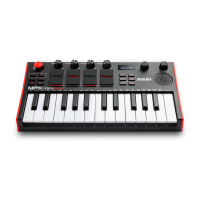
Do you have a question about the Akai MPK mini Play MK3 and is the answer not in the manual?
| Pad color | Black |
|---|---|
| Control type | Buttons, Rotary |
| Number of pads | 8 |
| Number of knobs | 6 |
| MIDI-keyboard number of keys | 25 keys |
| Product color | Black, Red |
| Octave adjustment | Yes |
| Interface | USB |
| Display type | OLED |
| Battery type | AA |
| Power source type | Battery |
| Number of batteries supported | 4 |
| Depth | 178 mm |
|---|---|
| Width | 317 mm |
| Height | 58 mm |
| Weight | 860 g |
Lists all items included in the MPK mini Play mk3 package.
Provides information on accessing product documentation, technical specifications, and registration.
Initial steps for playing sounds, accessing drum and keyboard sounds, and managing favorites.
Instructions for connecting and configuring the MPK mini Play mk3 with MPC Beats software.
Instructions for connecting and configuring the MPK mini Play mk3 with GarageBand.
General guidance for integrating the MPK mini Play mk3 with any digital audio workstation (DAW).
Details the 25-note velocity-sensitive keyboard and octave control.
Explains the velocity-sensitive pads for triggering sounds and accessing favorites.
Describes the 4-axis thumbstick for MIDI pitch bend and CC messages.
Covers Arpeggiator On/Off, Time Division, Mode, Latch, Octave, Swing, and Sync settings.
Explains Tap Tempo for arpeggiator timing and Octave Up/Down for keyboard range.
Details Full Level mode for consistent velocity and Note Repeat for rhythmic playback.
Covers Display Screen, Selector Knob, Keys, Drums, Favorites, and Internal Sounds buttons.
Describes Pad Bank A/B and Knob Bank A/B for switching control modes.
Explains the assignable knob for Filter and Attack settings or MIDI CC messages.
Details the assignable knob for Resonance and Release settings or MIDI CC messages.
Covers the assignable knob for Reverb Amount and Low EQ settings or MIDI CC messages.
Describes the assignable knob for Chorus Amount and High EQ settings or MIDI CC messages.
Adjusts the volume for internal sounds and headphone output.
Provides audio output for internal sounds, disabled when headphones are used.
Controls power to the unit, selectable between USB and Battery operation.
Connects to a computer for power and MIDI data transmission.
Connects headphones for private listening, disabling the internal speaker.
Socket for connecting a momentary-contact foot pedal for sound sustain.